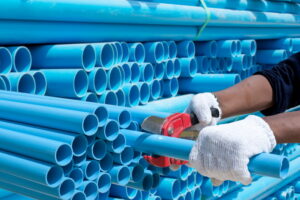Charleston has many vintage homes and it’s common for families to live in buildings built before 1950. An older house can have immense charm and beauty, but it can come with its share of problems from out-of-date fixtures. One of the biggest concerns with older homes is the piping which we’ll look at in this post.
If your home was built before 1980, there’s a chance you have pipes made of outdated materials that are prone to leaks and releasing harmful chemicals into the water. Fixing this requires working with professional repiping plumbers in Charleston, SC. We’re a local team who knows what to watch for in plumbing for older homes. You can rely on us to see you have the repiping your house needs.
Older Piping Material
Today, the most common materials used for residential plumbing are copper and plastics such as CPVC and PEX. Plumbers use a combination of these materials for new homes as well as for replacing older pipes. The older materials are still around, however, in homes that haven’t had plumbing renovation. Here are the major outdated pipe materials that may be in your house.
Lead Piping
Most people understand that lead piping isn’t good—but it’s still found in a surprising number of homes where the owners are unaware of its presence. Lead pipes corrode faster than either cast iron or galvanized steel pipes, but the main worry is that they allow harmful lead into the drinking water. We strongly recommend having lead pipes replaced as soon as possible.
Galvanized Steel
This is steel dipped in a zinc solution to help prevent rust and is common in homes built before the 1960s. At the time, it was an excellent replacement for lead pipes, but over time galvanized steel has shown its own set of flaws.
They have shorter service lives, and if your home has them, they’re almost certainly close to the end of the line. The biggest problem with these pipes is that they accumulate mineral buildup that increases water pressure as well as contaminates the water supply with lead.
Cast Iron
Iron is a strong and durable material that gave its name to an entire period of history: The Iron Age. But the Iron Age is long gone, and cast iron isn’t a desirable type of material for modern piping. It corrodes quicker than its replacements, it’s extremely heavy and difficult to work with, and it’s not easy to repair.
In fact, your household insurance may not cover repairs or replacements to cast iron pipes. You’ll find iron piping in many homes built before 1970.
Polybutylene
This is a type of plastic pipe that became popular as a replacement to older materials starting in 1978, as well as an inexpensive alternative to copper. The dream of polybutylene becoming the pipes of the future didn’t last, however, as they showed a tendency to become brittle and shatter.
Polybutylene was no longer installed after 1995, but between 6–10 million homes had them installed between ‘78 and ‘95. We recommend replacing all polybutylene pipes with either copper or one of the newer, more durable and flexible plastics.
Call on Carolina Climate Control: The Moose Is Loose in Your Neighborhood!

